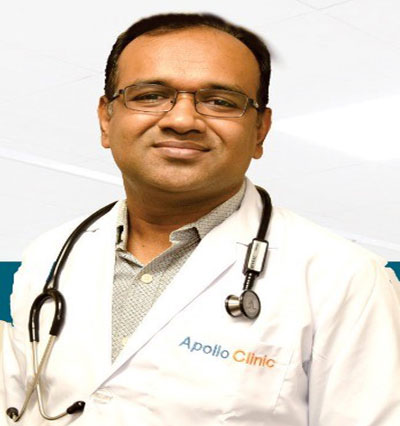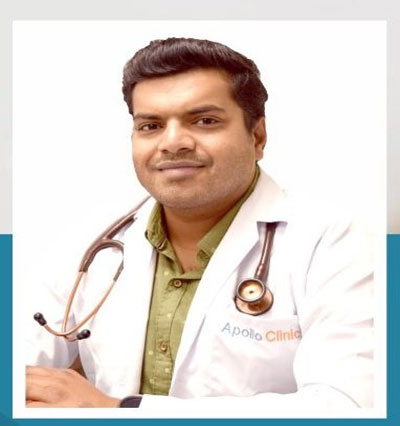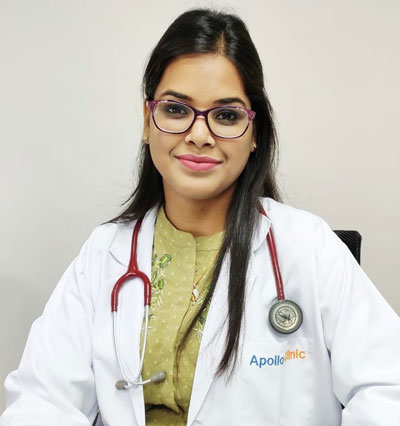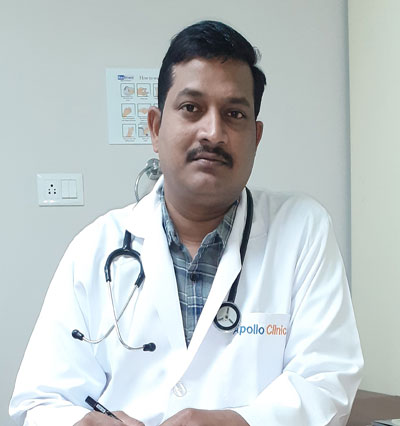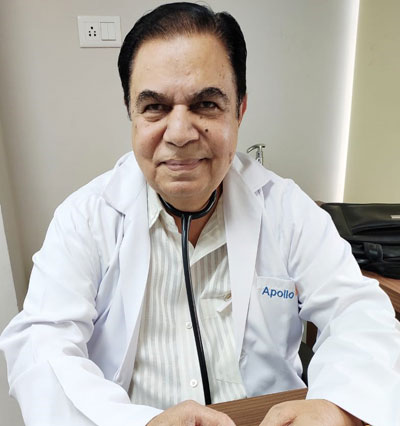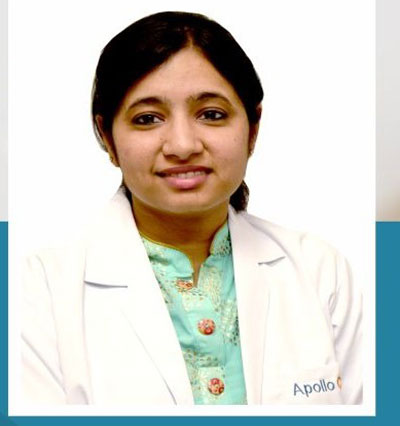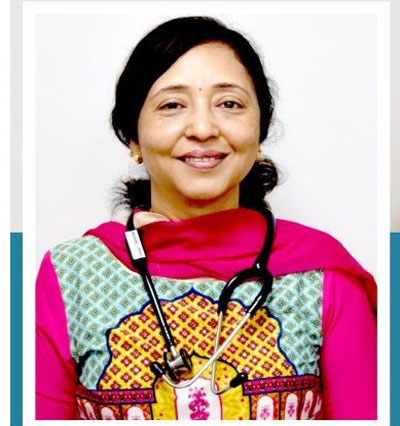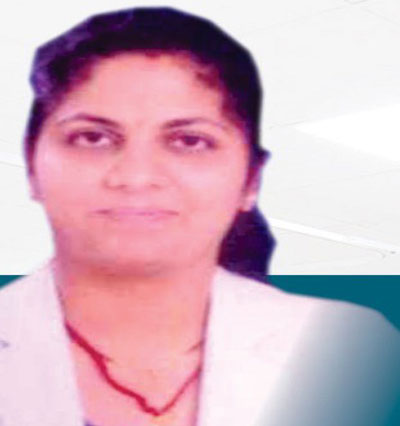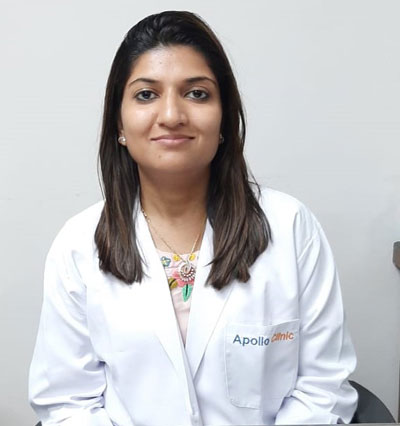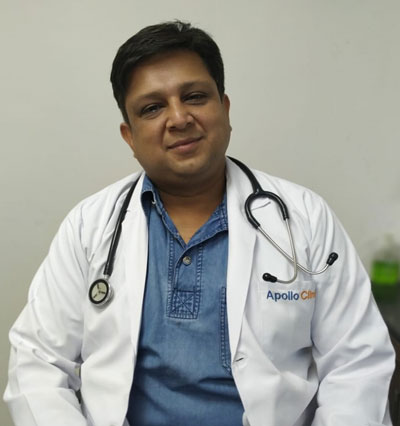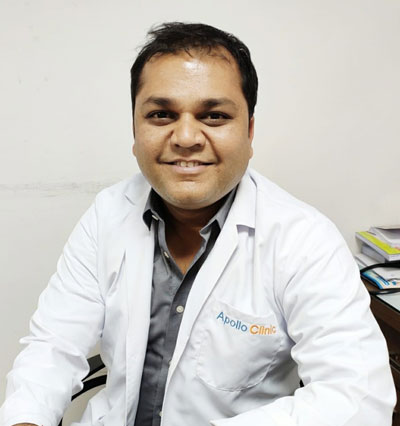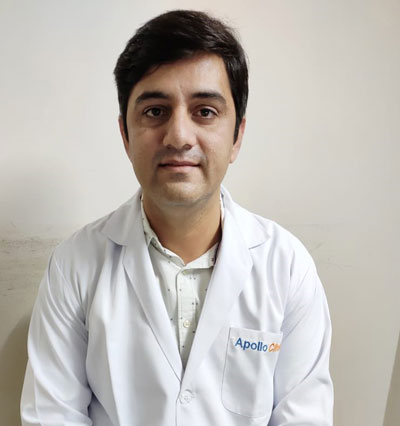

The Auditory Brainstem Response (ABR) test provides information about inner ear (cochlea) and brain function for hearing. Electrodes are placed around the ear to assess the hearing capacity of any adult, child or even a new-born baby
Stomach lining secretes hydrochloric acid in the stomach which helps in the digestion of food. A deficiency of hydrochloric acid secretion is called Achlorhydria.
Anterior Cruciate Ligament (ACL) is a ligament which runs diagonally deep inside the knee from the thigh bone to the top of the larger bone in the lower leg. The ligament maintains the position of the knee and prevents it from sliding it backwards. Any injury to it is called an ACL injury.
A potential medical emergency characterised by severe abdominal pain which usually requires immediate surgical intervention. An acute abdomen can be due to a problem with abdominal organs like appendicitis (inflamed appendix), cholecystitis (inflamed gallbladder), a perforated ulcer in the intestine, or a ruptured spleen.
An unusual reaction of your immune system to a foreign substance like food, drugs, dust, animals, metals, etc. is called an allergy.
Complete or partial loss of memory is called amnesia. Antegrade amnesia refers to a lack of memory of events occurring after a traumatic event, while retrograde amnesia refers to a lack of memory of events that occurred before the event.
The branch of science concerned with the bodily structure of humans, animals, and other living organisms is called anatomy. Observation, dissection of a dead specimen and microscopic examinations are some ways to study anatomy.
An abnormal and persistent fear of bacilli (bacteria). A phobia is an unreasonable sort of fear that can cause avoidance and panic. Phobias are a relatively common type of anxiety disorder.
The branch of medicine which deals with the study and treatment of obesity. A Bariatric specialist provides management of obesity in the form of diet and nutrition counselling, exercise training, behaviour modification and surgery
Bed sores are also called pressure sores. It is a sensitive reddish area of degenerating, ulcerated skin caused by prolonged pressure and lack of movement, and worsened by exposure to urine or other irritants on the skin. Bedsores most often develop on skin that covers bony areas of the body, such as the heels, ankles, hips and tailbone.
Belching or burping is the natural process of releasing air and gas from the mouth, the gas accumulates in the stomach, thereby relieving distension
The process of removing tissue from a live human or animal to verify the presence of any disease, identify the cause of the disease and evaluate the extent of illness progression. A biopsy is usually done for the diagnosis of cancer.
Also called bleb or bulla, it is the collection of fluid underneath the top layer of skin. There are many causes of blisters, including burns, friction and diseases of the skin.
Stands for Body mass index. BMI is defined as body mass divided by the square of the body height. A patient is categorised as underweight, normal weight, overweight, and obese as per BMI. BMI is used to predict the risk of chronic diseases like hypertension and diabetes in a patient.
Bone marrow is the soft, spongy, gelatinous tissue found in the hollow spaces in the interior of large bones like hip and thigh bones. It contains stem cells which produce different types of blood cells.
Bradycardia is defined as a slow heart rate of fewer than 60 beats per minute. The condition can cause symptoms like fatigue, weakness, dizziness, and fainting.
The major air passage of the lungs which diverge from the end of wind pipe.
The bypass is a surgical procedure of creating an alternative passage to divert the flow of blood or other bodily fluid or dodges an obstructed or diseased organ. Bypass surgeries are done on various organs like heart, intestine and stomach.
Calcinosis is a term used to describe a group of disorders in which small white calcium lumps are formed under the skin. Calcinosis may range from one very tiny deposit to large (and often painful) clusters or lumps which may break through the skin and leak a chalky white liquid. Although they may appear anywhere but they most commonly occur on the hands, or near joints such as elbows or knees
A calorie is a unit used to measure the amount of energy in food and beverages. To lose weight, you need to eat fewer calories than your body burns each day.
Cardiology is a branch of medicine which deals with diagnosis, treatment and management of heart-related problems.
The carotid arteries are the major blood vessels that supply oxygen-rich blood to the head, brain and face. There are two carotid arteries, located on each side of the neck.
Cellulitis is an acute bacterial infection of the skin and tissues beneath the skin and may also spread to lymph nodes and bloodstream. Cellulitis appears as a swollen, red area of skin that feels hot and tender. A person with cellulitis can also develop fever and/or swollen lymph nodes in the area of the infection. Staphylococcus and Streptococcus are the types of bacteria that are usually responsible for cellulitis.
It is also known as gallbladder which is a pear-shaped organ attached by ducts to the liver. Bile (a digestive fluid produced by the liver) is stored in the cholecyst before it is released in to the small intestine
Cilia are microscopic, hair-like projections present on the surface of animal cells. Cilia are of two types: motile and non-motile cilia.
It is also known as first milk. It is a sticky white or yellow fluid secreted by the breasts during the first few days after giving birth. It is low in fat and contains a high amount of carbohydrates, protein, and antibodies. Antibody levels in colostrums can be 100 times higher than levels in regular cow’s milk.
Medical consultation is a meeting between the patient and the doctor where the doctor reviews the patient’s medical history, examines the patient, discusses patient’s problem, and accordingly gives a recommendation for diagnostics, treatment, and medication.
The chronic obstructive pulmonary disease is a progressive (the disease gets worse over time) lung disease that creates difficulty in breathing and obstruction of the airways. Cigarette smoking is the leading cause of COPD.
Cyanosis is a bluish discoloration of the skin and mucous membranes caused by the lack of oxygen in the blood. Cyanosis is associated with cold temperatures, heart failure, lung diseases, etc
A condition in which the body becomes weakened or lacks strength due to long term disease.
A defibrillator is a device in which a therapeutic dose of electric current is given to the heart to treat life threatening conditions that affect the normal heart rate such as cardiac arrhythmia, ventricular fibrillation and ventricular tachycardia.
A deformity is a condition in which a part of the body or organ varies from the normal or expected shape and size, due to an accident or genetic abnormality.
Dehydration is a condition that occurs when the body loses more fluid than the amount of water that is consumed. Dehydration can be mild, moderate, or severe, based on how much fluid is lost or not replaced. Severe dehydration can lead to death.
Delirium is an acutely disturbed state of mind characterised by restlessness, illusions, incoherence, occurring in intoxication, fever and other disorders.
Fever caused due to viral infection of dengue virus transmitted to the body by a mosquito bite.
An adjective used to explain anything relating to teeth. Dentistry: A Medical science which deals with various problems related to teeth.
Depression is a psychological disorder that causes a persistent feeling of sadness and loss of interest. Also called major depressive disorder or clinical depression, it affects how you feel, think and behave and can lead to a variety of emotional and physical problems.
Dermatology is a branch of medicine dealing with problems related to skin, hair and nails
The descending aorta is the part of the aorta, the largest artery in the body that runs down through the chest and the abdomen
Dual-energy X-ray absorptiometry (DEXA) scan is a specialised X-ray which assesses the bone-mineral density.
Dialysis is a life-support treatment that uses a special machine to remove waste products and excess fluid and salt from blood, in patients with kidney dysfunction
Dizziness is a common symptom of various disorders in which a person feels light-headedness, woozy, weak or unbalanced. It affects the sensory organs, specifically the eyes and ears.
It Stands for ‘Directly Observed Treatment, Short-course’ also known as TB-DOTS. It is the internationally recommended strategy to treat tuberculosis (TB) in a short span of time, where healthcare volunteers make the patient take drugs medicine at the right time and right dosage in front of them, thus avoiding defaulters and relapses of TB.
Electrocardiogram (ECG) is a diagnostic tool used for assessing as well as recording the electrical activity of the heart. ECG is done to diagnose different heart conditions.
Extracorporeal membrane oxygenation is a technique of providing both artificial cardiac and respiratory support to the person whose heart and lungs are unable to provide an adequate amount of gas exchange to sustain a healthy life. The purpose of ECMO is to provide enough oxygen to the body thus allowing time for the lungs and heart to heal up.
It is a term used to denote a procedure involved the surgical removal of a specified part of the body. For example, the surgical removal of a lump known as a lumpectomy and an appendectomy is the removal of the appendix.
Ectopic pregnancy is a life-threatening condition which occurs when the fertilised egg attaches itself in a place other than inside the uterus, such as in one of the fallopian tubes.
Oedema is the medical term which is used to denote the swelling of soft tissues as a result of excess fluid accumulation.
ELISA (enzyme-linked immunosorbent assay) is a plate-based assay technique designed for detecting and quantifying substances such as antibodies, peptides, proteins, and hormones.
Elliptocytosis is a blood-related disorder passed down through families in which abnormally elliptically shaped t-red blood cells are formed which break easily (haemolysis).
An embolism is the lodging of an embolus, a blockage-causing piece of material, inside a blood vessel. The embolus may be a blood clot (thrombus) a fat globule, a bubble of air or other gas (gas embolism), or foreign material. An embolism can cause partial or total blockage of blood flow in the affected vessel.
An organism in the early stages of growth and differentiation, from fertilisation to the beginning of the third month of pregnancy (in humans) is called an embryo. After that point in time, an embryo is called a foetus.
ENT (ear, nose, and throat) is a branch of medicine dealing with problems and diseases related to ear, nose and throat
The facial nerve, or cranial nerve (CN) VII, is the nerve of facial expression. This nerve performs two primary functions. It controls facial muscles expressions and conveys some sensory information from the tongue and the interior of the mouth to the brain.
During bleeding a series of reactions take place in the body that helps stop the bleeding and the process is known as coagulation. It involves special proteins called coagulants, or clotting factors. Factor X is one such coagulation factor. Production of factor X takes place in the liver.
Fascia is a specialised system of the body that has an appearance similar to a spider's web or a sweater. A fascia is a band or sheet of connective tissue, primarily collagen, beneath the skin that attaches, stabilises, encloses, and separates muscles and other internal organs.
A fat embolism is a state in which a fat particle or droplet travels through the circulatory system and eventually blocks a blood vessel. It is mostly caused by physical trauma such as a fracture of long bones, soft tissue trauma and burns.
A built up of fat (Steatosis) in the liver that is above 5-10% of the total weight of the organ is defined as fatty liver.
increased body temperature is called fever. In medical terms, an a.m. temperature of >37.2°C (>98.9°F) or a p.m. temperature of >37.7°C (>99.9°F) defines a fever.
The fibula or calf bone is thin and the smaller of the two bones in the lower leg. It plays a significant role in stabilising the ankle and supporting the muscles of the lower leg
Flail chest is a serious condition that can lead to long-term disability and even death. It is a situation in which a portion of the rib cage is separated from the rest of the chest wall, usually due to a severe blunt trauma, such as a serious fall or a car accident. This affected portion is unable to contribute to a normal expansion of the lung and thus hampers normal breathing.
Foramen is an opening, hole, or passage, especially in a bone. Foramina inside the body of humans typically help connect muscles, nerves, arteries, veins, or other structures to one part of the body with another. Although a foramen is usually through bone, it can be an opening through other types of tissue, as with the foramen ovale in the heart.
Fugue is a rare psychiatric disorder in which an individual experiences a disruption in memory, awareness and identity. Sometimes he/she might even create new identities. This may last from less than a day to several months and generally brought on by severe stress or trauma.
Galactose is a white, crystalline, water-soluble monosaccharide sugar obtained from milk sugar that is less sweet than glucose and fructose. In the human body, most of the ingested galactose is converted to glucose, which can provide 4.1 kilocalories per gram of energy.
A pear-shaped organ located below the liver which stores the bile secreted by the liver. During and after a meal, the gallbladder contracts and secretes the bile through the bile ducts into the intestines to assist in food digestion.
A lighted, flexible tubular instrument that is put through the mouth for the examination of the internal tissues of oesophagus, stomach, and duodenum. The instrument can also be used to remove a small part of tissue from the internal organs.
Glaucoma is an eye disease that is often associated with elevated intraocular pressure, in which damage to the eye (optic) nerve can lead to loss of vision and even blindness.
Gluten is a mixture of proteins found in wheat and related grains, including barley, rye, oat, etc. Some people are allergic to gluten, as a result, they are not able to digest or break down the gluten.
Great saphenous vein is a superficial vein of the leg. It is the longest vein in the human body, extending from the top of the foot to the upper thigh and groin. The great saphenous vein plays an important role in returning blood from the superficial tissues of the leg to the heart and is also used in several medical procedures due to its size and superficial location.
Gynaecology is a branch of medicine which deals with diagnosis, treatment, and management of diseases and conditions occurring in girls and women.
Gynephobia is the fear or hatred (or both) of women. Usually, men suffer from this phobia, which is also known by names like Gynephobia or Feminophobia. Such individuals fear women or having sexual intercourse with them.
Habitual abortion is defined as three or more pregnancy losses in continuation before 20 weeks of gestation. The condition may result from chronic infection, severe kidney problems, serious foetal abnormality, endocrine disorders, and structural defects of the cervix or uterus or immune problems.
Hallucinations are sensations that appear to be real but are created by the mind. Examples include seeing things that are not there, hearing voices or other sounds, experiencing body sensations like crawling feelings on the skin, or smelling odours that are not there.
There are two types of cells in the body - haploid cells and diploid cells. They differ by a number of chromosomes their cell contains. Haploid cells have half the number of chromosomes (n) as diploid - i.e. a haploid cell contains only one complete set of chromosomes. Example is sperm and ova.
There are two types of cells in the body - haploid cells and diploid cells. They differ on the basis of number of chromosomes their cell contains. Haploid cells have half the number of chromosomes (n) as diploid - i.e. a haploid cell contains only one complete set of chromosomes. Example is sperm and ova.
A hematoma is an abnormal and localised collection of blood outside the blood vessels. It occurs because the wall of an artery, vein, or capillary, has been damaged and blood has leaked into tissues which may cause symptoms of inflammation including pain, swelling and redness.
Haemorrhage is also known as bleeding. It is the abnormal flow of blood. Bleeding can occur internally, where blood leaks from blood vessels inside the body, or externally, either through a natural opening such as the mouth, nose, ear, urethra, vagina or anus or through a break in the skin.
An injectable anticoagulant (anti-clotting) medication used to prevent and treat blood clots in the veins, arteries, or lungs.
A hiccup is an extraordinary type of respiratory movement involving a sudden inspiration (intake of air) due to an involuntary contraction of the diaphragm accompanied by closure of the glottis (the vocal apparatus of the larynx).
As per the new guidelines JNC 8 OR 7, hypertension is defined as blood pressure above 140/90 mm Hg.
Is another word for Jaundice. It is a disease in which the skin and whites of the eyes becomes yellowish or greenish due to high bilirubin level. Faces and urine may also become pale and dark.
Relating to or denoting any disease or condition which arises spontaneously or for which the cause is unknown.
A branch of biomedical science that covers the study of immune systems in all organisms, including its structure and function, disorders of the immune system, blood banking, immunisation, and organ transplantation.
Localised hardening of the soft tissue of the body particularly the skin caused by oedema, inflammation, or infiltration.
A restriction of the blood supply to an organ or region of tissue, typically by a thrombus or embolus (blood clot) causing a local death of that tissue.
Infectivity is the ability of a pathogen to establish an infection in persons exposed to an infectious agent
Inflammation is a physical body process by which the body's white blood cells and substances they produce protects a body from infection as a result part of the body becomes reddened, swollen, hot which is often painful. Inflammation is often characterised by redness, swelling, warmth, and sometimes pain and some immobility.
Insomnia is a sleep disorder that is characterised by the difficulty of falling asleep. The condition may occur due to a number of factors, waking up frequently during the night with difficulty returning to sleep, waking up too early in the morning, or unrefreshing sleep
Insulin is a hormone released from the pancreas which regulates blood glucose levels in the body.
Jaundice also known as icterus is a condition in which skin and the whites of eyes turn yellow. It is caused by a high concentration of bilirubin. Bilirubin is a yellow chemical in haemoglobin that carries oxygen in red blood cells.
The jaw is a set of bones that hold teeth. It consists of two main parts. The upper part is the maxilla which doesn’t move. The lower part is called the mandible which is movable
Also called jennerization. It is the production of immunity to a disease by inoculation of an attenuated form of the virus causing the disease.
A temporary disorder that causes fatigue, insomnia, and other symptoms as a result of rapid air travel across time zones. It is also known as time zone change syndrome or desynchronosis. It is a temporary sleep problem that causes fatigue, insomnia, and other symptoms among people who travel across multiple time zones by flight.
Very small semi-circular white spots on the toenails. These spots result from injury to the base (matrix) of the nail
Joint aspiration is a procedure to remove fluid from the space around a joint using a needle and syringe to relieve swelling or to obtain fluid for diagnosing a joint disorder.
The presence of potassium in the blood. It is the base term used to denote abnormally high blood potassium (hyperkalemia) and low blood potassium (hypokalemia).
Laser eye surgery procedures performed to correct a person's vision there by reducing dependency on glasses or contact lenses. In this process using a laser, a portion of the cornea which distracts the refraction is removed.
Keratitis is the medical term for inflammation of the cornea. The cornea is the outermost dome-shaped window in the front of the eye and covers the pupil and iris (the coloured ring around the pupil). The most common causes of keratitis are infection and injury.
A kidney stone is a hard, crystalline mineral material formed within the kidney or urinary tract. Kidney stones are known to be one of the most painful medical conditions, and it is a common cause of blood in the urine and pain in the abdomen or groin.
A group of bacteria that normally live in the intestinal tract, but can cause infections especially urinary infections and pneumonia. Klebsiella is frequently the cause of infections acquired in hospitals.
Ligaments are strong, elastic bands of tissue present in the centre of the knee that connects the thigh bone to the bone of the leg. They provide strength and stability to the joint.
It is an also called patella it is a small bone located in front of a knee joint. It protects the knee and connects the muscles in the front of the thigh to the legs.
A tumour of the ovary that is caused by the spread of metastatic cancer of the gastrointestinal tract, mostly from the stomach.
Brittle diabetes mellitus (or labile diabetes) is a term used to describe particularly hard to control type 1 diabetes. People having brittle diabetes will experience frequent, extreme changes in blood glucose levels, causing high or low blood glucose level.
It a state of an excessive amount of tear production as a result of eye injury or irritation.
Laryngitis is an inflammation of voice box (larynx). This is most often caused from overuse, irritation or viral infections.
The larynx is another name for the voice box. It is a hollow muscular tube about 2 inches (5cm) long in adults. It occurs above the windpipe (trachea) in the neck and in front of the food pipe. The larynx Protects windpipe during swallowing, allows the air to reach the lungs and produces sound for speaking.
An abbreviation standing for laser-assisted in situ keratomileusis. It is a kind of laser eye surgery designed to change the shape of the cornea and to clear front part of the eye. It is done to eliminate or reduce the need for glasses and contact lenses in cases of severe short and far sightedness.
An acute or chronic poisoning caused by the absorption of lead or any of its salts into the body. Lead poisoning is an environmental hazard that is capable of causing mental retardation, behavioural disturbance, and brain damage.
A hormone produced mainly by adipocytes (fat cells). It is involved in the regulation of body fat. Leptin interacts with areas of the brain that control hunger and behaviour and signals that the body has had enough to eat.
Lipid screen is a blood test used to measure the levels of lipids (cholesterol, triglycerides, LDL, HDL) in the blood which can help in evaluating risk for cardiac complications.
The living organisms of a region that are large enough to be seen with the naked eye. Gut microbiota (formerly called gut flora) are the microbe population living in the intestines which help digest food and synthesises some vitamins such as folic acid (B12) and vitamin K.
Macrolide is a class of antibiotics characterised by large lactones ring structures. They are capable of inhibiting inhibit the growth of bacteria and are often prescribed for the treatment of common bacterial infections.
Macrophages are important cells of the immune system that are formed in response to an infection or the accumulation of damaged or dead cells. They recognise, engulf and destroy foreign cells.
Malaria is a life-threatening blood disease caused by protozoan parasites. This parasite is transmitted to humans through the bite of a mosquito named Anopheles or by a contaminated needle or blood transfusion. These parasites multiply in the host's liver before infecting and destroying red blood cells.
Malnutrition or malnourishment is a condition that results from eating a diet in which nutrients are either not enough or are too much, such that the diet causes different health issues.
Mammography is an X-ray of the breast and is done to observe the anatomy of the breast.
Mast cells are granulocytes found in connective tissue beneath the skin. These are responsible for inflammatory and allergic reactions. During allergic reactions mast cell is injured and releases strong chemicals like histamine, into the tissues and blood. These released chemicals are responsible for inflammation.
Measles, or rubeola, is a viral infection of the respiratory system. Measles is a very contagious disease that can spread through contact with infected mucus and saliva. It causes total-body skin rash and flu-like symptoms, including fever, cough, and runny nose.
A hormone that is produced by the pineal gland in the brain. Pineal gland releases this hormone after 9 pm in the body. This hormone is involved in regulating sleeping and waking cycles.
Biochemical processes that occur within living organisms for the production of energy. Metabolism consists of anabolism (the buildup of substances) and catabolism (the breakdown of substances).
A drug that counteracts the action of morphine and other opiates like respiratory depression, sedation and hypotension.
This is the passage from the nose to the stomach. Abbreviated as ‘NG’.
A substance that increases urinary excretion of sodium by decreasing the reabsorption of sodium ions from the glomerular filtrate in the kidneys
Nausea is the sensation of an urge to vomit. Nausea can also be associated with a headache, fever, diarrhoea, gas, and abdominal pain. Nausea can be caused by systemic illnesses (such as influenza), medications, pain, motion sickness, etc.
A newborn baby, specifically a baby in the first 4 weeks or 1 month after birth. It is a time when changes are very rapid.
Anything arising from the nerves or the nervous system. For example, neurogenic pain is pain that originates in the nerves.
The medical speciality concerned with the diagnosis and treatment of disorders of the nervous system, which includes the brain, the spinal cord, and the nerves
Nicotinic acid is one of the B-complex vitamins-B 3. It is used to treat high cholesterol in the blood. Deficiency of niacin in the diet results in the disease pellagra ( Niacin deficiency). Insufficient niacin in the diet can cause nausea, skin and mouth lesions, anaemia, headaches, and tiredness.
An alkaloid (a nitrogen-containing chemical) made by the tobacco plant or produced synthetically. It is the main content in cigarettes. It shows a deteriorated effect on living beings. It increases the heart rate, heart stroke volume, and oxygen consumption by the heart.
Nutrition is referred to different elements of food like carbohydrate, protein, vitamins, minerals, and fibre which are required for proper growth and health.
The term 'obese' describes a person who's extremely overweight. A person is considered obese if bodyweight is at least 20% higher than it should be.
The medical speciality dedicated to managing pregnancy, Labour and the puerperium (the time after delivery).
A symptom often due to disease of the oesophagus characterized by pain on swallowing food and fluids.
The production of abnormally small amounts of urine. It is one of the clinical hallmarks of renal failure. It has been used as a criterion for diagnosing and staging acute kidney injury.
The omentum found in the lower abdominal area. It is a membranous double layer containing fatty tissues that cover and support intestines and other organs found in the lower abdomen. It stores fat deposits, it contains milky spots that contain white blood cells (boost immunity), and it isolates wounds and infections by wrapping around infected areas.
A physician who specialises in the prevention, diagnosis and treatment of cancer.
Female gamete or sex cell in an ovary. An oocyte is capable of developing a new individual of the same species when fertilised by a sperm.
A practitioner who provides primary eye and vision care performs eye examinations to detect vision problems and prescribes corrective lenses to correct eye related problems.
Orthopaedics is a branch of medicine which deals with treatment and correction of problems related to bones, joints, muscles, ligaments, and tendons.
A pacemaker is a small device that's placed in the chest or abdomen to help control abnormal heart beats. This device uses low-energy electrical pulses to prompt the heart to beat at a normal rate.
It is a condition in which skin becomes thick, similar to a pachyderm like an elephant, rhinoceros, or hippopotamus. Pachyderma can occur in several medical conditions
Pachyonychia congenita is an autosomal dominant skin disorder that primarily affects the nails and skin. It is characterised by excess keratin in nail beds and thickening of the nails, oral lesions that look like thick white plaques and painful calluses and blisters.
Paediatrics is a branch of medicine which deals with diagnosis, treatment, and management of diseases and conditions occurring in children.
The roof of the mouth that separates the oral and nasal cavities. The front portion of palate is bony called hard palate, and the back portion is muscular called soft palate.
A method to make the effects of (something, such as an illness) less painful, harmful, or harsh.
Palpitation is an abnormality of heart and is characterised by a feeling of fast heartbeats, pounding, or fluttering. Palpitation can be felt in the chest, throat, and neck.
A spongy, tube-shaped organ that is about 6 inches long and is located in the back of the abdomen, behind the stomach. It secretes digestive enzymes and an important hormone named insulin. Insulin helps to control the glucose level in blood.
Paralysis is a loss of muscle function in a part of the body and is identified by loss of sensation in that area. It can be localised or generalised, partial or complete, temporary or permanent
The parotid gland is a major salivary gland. In humans, the two parotid glands are present on either side of the mouth and in front of both ears. Parotid glands secrete thin, watery secretion called saliva into the mouth. Saliva helps in swallowing and digestion of food.
A violent attack of symptoms or a sudden increase in the intensity of the disease. It may be due to the sudden occurrence of symptoms or the acute exacerbation (the abrupt worsening) of pre-existing symptoms.
Pasteurisation (or pasteurisation) is a process of making foods stay fresh. It involves heating the food to kill most harmful microorganisms without harming the flavour or quality of the food.
Polycystic Ovarian Disease (PCOD) is a disease occurring in women and is characterised by small fluid-filled cysts on the ovaries. A woman with PCOD has abnormal hormonal changes which cause irregularities of menstruation, infertility and abnormal facial hair growth.
Preventive care is referred to the steps taken to prevent disease. Preventive care includes immunisation, early screening of illness, and spreading awareness about hygiene and healthy lifestyle.
A Chinese herb also called sweet wormwood. The antimalarial agent named artemisinin is extracted from this herb.
A large muscle group that includes the four prevailing muscles on the front of the thigh.
The weakness of all four limbs, both arms and both legs, happens due to muscular dystrophy.
Paralysis caused by illness or injury that results in the partial or total loss of use of all four limbs i.e. both arms and both legs. It usually occurs due to a high spinal cord injury.
A period of isolation of the infected person to control the spread of the infectious disease. Before the era of antibiotics and other medications, quarantine was one of the few available means for halting the spread of infectious diseases.
The moment during pregnancy when the pregnant lady Feels the movement of the baby in the uterus. For the first time, 13-25 weeks is a broad range of when the first detection of movement can be felt.
The antimalarial agent used to treat malaria. It was first isolated from the bark of the cinchona plant.
A potentially fatal viral infection that attacks the central nervous system. It causes acute inflammation of the brain in humans and other mammals. Rabies is carried by wild animals (particularly bats and racoons) and finds its way to humans by many routes such as dog bites from infected dogs.
The medical speciality concerned with the use of radiation for the diagnosis and treatment of disease. A variety of imaging techniques such as X-ray radiography, ultrasound, computed tomography (CT), etc. are used.
Breaking out (eruption) of the skin results in itchy, red, painful, and irritated skin. A rash can be caused by an underlying medical condition, hormonal cycles, allergies, or contact with irritants.
Radioallergosorbent test is an allergy test that is done on a sample of blood. RAST is used to detect the allergic sensitivity of a person towards specific substances.
Short form of red blood cells. These are the cells that supply oxygen through the blood to different body tissue. The red blood cells are also known as red corpuscles or erythrocytes.
The term used when liquid backs up into the oesophagus from the stomach.
Renal refers to the kidney. A renal stone is a stone in the kidney (or lower down in the urinary tract). Renal stones are a common cause of blood in the urine and pain in the abdomen, flank, or groin.
The retina is the nerve layer that lines the back of the eye. It senses light and creates impulses that travel through the optic nerve to the brain for visual recognition.
Representational oligonucleotide microarray analysis (ROMA). A method for the detection of the genomic defect between any two samples of DNA.
A triangular large bone in the lower back of the spine formed from fused vertebrae and situated between the two hip bones of the pelvis
A superficial skin infection caused by a fungus, affecting the scalp. Most cases of scalp ringworm are caught from person to person via touching, sharing towels, etc.
A hormone that is made by glands in the small intestine whose primary function is to stimulate the secretion of liver and pancreas.
The S-shaped last part of the large intestine which leads to the rectum. Its function is to store faecal wastes until they are ready to leave the body
The normal increase in heart rate that occurs during breathing.
The long flat bone in the upper middle of the front of the chest. The sternum joins with the cartilages of the first seven ribs and with the clavicle (collarbone) on either side.
The long flat bone in the upper middle of the front of the chest. The sternum joins with the cartilages of the first seven ribs and with the clavicle (collarbone) on either side
Sunburn is an inflammation of the skin that develops in response to excess exposure to ultraviolet (UV) radiation from the sun or from tanning beds that emit UV radiation.
The branch of medicine that employs operations in the treatment of disease or injury. Surgery can involve cutting, abrading, suturing, transplanting or otherwise physically changing body tissues and organs.
Swelling or enlargement of the tongue. A swollen tongue can be a symptom of glossitis, an inflammation of the tongue that can be caused by infections, local irritation or burns, and allergic reactions.
Tabes dorsalis is a slow degeneration of the nerve cells and nerve fibres of the spinal cord that carry sensory information to the brain. Tabes dorsalis is the result of an untreated syphilis infection. Symptoms include weakness, diminished reflexes, unsteady gait, progressive degeneration of the joints, loss of coordination, episodes of intense pain and disturbed sensation, personality changes, dementia, deafness, visual impairment, and impaired response to light. The disease is more frequent in males than in females.
Tachypnea is a condition that causes rapid and shallow breathing due to an imbalance between carbon dioxide and oxygen in the body. Tachypnea can be an early medical sign of pneumonia in children.
An often fatal infectious disease that is caused by the bacterium Clostridium tetani, which usually enters the body through a puncture, a cut, or an open wound. It is characterised by muscle spasms. It can lead to "locking" of the jaw. This makes it impossible to open mouth or swallow.
It is also known as a chest. The part of the body that is located between the abdomen and the neck. Within the thorax are the lungs, the heart, and the first section of the aorta.
A butterfly shaped gland found at the front of the neck that secretes the thyroxine hormone. This hormone plays vital roles in digestion, heart and muscle function, brain development and maintenance of bones.
Treadmill Test (TMT) is a test to evaluate the heart’s response to physical stress. The test is also known as Stress Test or Exercise test.
Small masses of lymphoid tissue at the back and on both sides of the throat. The tonsils help to fight infections.
An abnormal, repetitive shaking movement of the body. Tremors have many causes and can be inherited, related to illnesses (such as thyroid disease), or caused by fever, hypothermia, drugs or fear.
An infection caused by the bacterium called Mycobacterium tuberculosis. Usually, affects the lung. The common symptoms of TB are Coughing, sometimes with mucus or blood, chills, fatigue, fever, loss of weight, loss of appetite and night sweats.
The degree of elasticity of skin sometimes referred to as skin turgor. A decrease in skin turgor is indicated when the skin (on the back of the hand for an adult or on the abdomen for a child) is pulled up for a few seconds and does not return to its original state. The assessment of skin turgor is used clinically to determine the extent of dehydration, or fluid loss, in the body.
An acute illness with fever, caused by infection with the bacterium Salmonella typhi. Typhoid fever has an insidious onset, with fever, headache, constipation, malaise, chills, and muscle pain.
A lesion that has been eroding away the skin or mucous membrane which may be painful. Ulcers can have various causes, depending on their location
The larger of the two long bones within the forearm. (The smaller one is the radius.) The ulna is on the same side of the arm as the little finger.
Cancer of the gums. It is often associated with the use of smokeless (chewing) tobacco.
Ultrasound imaging uses high-frequency sound waves to produce pictures of the inside of the body. It is used to help diagnose the causes of pain, swelling and infection in the body’s internal organs and to examine a baby in pregnant women.
Upper respiratory infection. Infection of the air passages of the nose, the throat, and/or bronchial tubes.
The unintentional loss of urine. Inability to hold urine in the bladder due to loss of voluntary control over the urinary sphincters or bladder (where urine store).
Uvulitis is severe swelling of the uvula. The uvula is the small piece of tissue that hangs in the back of the throat. Uvulitis is usually caused by an infection, an injury to the back of the throat, or an allergic reaction.
Microbial preparations of killed or modified or less active microorganisms that can stimulate an immune response in the body to prevent future infection with similar microorganisms
Each of the tenth pair of cranial nerves that supplies nerve fibres to the pharynx (throat), larynx (voice box), trachea (windpipe), lungs, heart, oesophagus, and intestinal tract, as far as the transverse portion of the colon
The exchange of air between the lungs and the atmosphere so that oxygen can be exchanged for carbon dioxide inside the alveoli (the tiny air sacs in the lungs).
A natural white, cheesy substance that covers and protects the skin of a foetus. Vernix is also present all over the skin of a baby at birth.
The presence of a virus in the blood. Viremia is analogous to bacteremia (the presence of bacteria in the blood) and parasitemia (the presence of a parasite in the blood).
A small infectious agent that replicates only inside the living cells of other organisms. Viruses can infect all types of life forms, from animals and plants to microorganisms
A condition in which the skin turns white due to the loss of pigment from the melanocytes cells. These are cells that produce the pigment melanin that gives the skin a different colour.
One of two small bands of muscle within the larynx. These muscles vibrate to produce the voice. The vocal cords form a "V" inside the larynx.
Gradual loss of weight, deterioration, emaciation. As in a wasting disease.
Stands for white blood cells also called leukocytes. These are blood cells that are involved in protecting the body against both infectious disease and foreign invaders.
A red bump, ridge or swelling of unbroken skin raised by a stinging blow or by an allergic reaction to foods, drugs or insect bites, as in hives (urticaria).
A whistling noise that is produced in the chest during breathing. Wheezing occurs when the airways become narrowed or compressed due to blockage as in asthma.
Whiplash is a non-medical term describing a range of injuries to the neck caused by or related to a sudden distortion of the neck. Whiplash is commonly associated with motor vehicle accidents.
The womb (uterus) is a hollow, pear-shaped reproductive organ located in a woman's lower abdomen between the bladder and the rectum. During pregnancy, foetus grows inside the womb.
The part of the hand that is nearest the forearm and consists of the carpal bones and the associated soft tissues
A gene on the X chromosome. An X-linked disorder is associated with or caused by a gene on the X chromosome.
High-energy radiation used in low doses to make internal images that help to diagnose diseases and in high doses used to treat cancer.
Tiny (1-2 mm) yellowish plaques that are slightly raised on the skin surface of the upper or lower eyelids.
A condition in which yellowish fatty deposits beneath the skin. They range from very small to up to 3 inches in size. Xanthomas may appear anywhere on the body but are most frequently found on the elbows, joints, tendons, knees, hands, feet, and buttocks.
Abnormally dry skin. Xeroderma can be caused by a deficiency of vitamin A, systemic illness (such as hypothyroidism), overexposure to sunlight, and medication
Abnormal dryness of the skin, mucous membranes, or conjunctiva (xerophthalmia).
Dry mouth. Xerostomia can be associated with systemic diseases, or it can be a side effect of medication and poor dental hygiene.
The lower part of the breastbone. The xiphoid process has no particular function and ranges in size from minuscule to several inches in length.
A brightly fluorescent body seen under the microscope in cells containing a Y chromosome when the cells are stained with the dye quinacrine. Quinacrine lights up the Y chromosome more than other chromosomes.
The sex chromosome that is found, together with an X chromosome, in males.
The presence of a gene on the Y chromosome.
An acute illness caused by a virus called a Flavi virus. In severe cases, the viral infection causes high fever, bleeding into the skin, and necrosis (death) of cells in the kidney and liver.
An infectious disease caused by a bacterium called Yersinia enterocolitis. It is characterised by fever, abdominal pain and diarrhoea
A rare elemental metal. A radioactive form of yttrium is used in radiation therapy and some types of immunotherapy.
A sex chromosome in certain animals, such as chickens, turkeys, and moths. In humans, males are XY and females XX, but in animals with a Z chromosome, males are ZZ and females are WZ.
Stands for zygote intrafallopian transfer. A method used to treat infertility in which an egg fertilised in vitro (outside the body) is placed into a woman's fallopian tube.
Also called Brill-Zinsser disease. It is a delayed relapse of epidemic typhus, caused by Rickettsia prowazekii.
The zona pellucida is the transparent, thick outer layer of the ovum in mammals that protects the ovum as it travels from the ovary to the uterus. To fertilise the egg the sperm first penetrate this outer layer. After fertilisation, the zona pellucida disappears, to permit implantation in the uterus.
An abnormal and persistent fear of animals.
The bone that forms the prominence of the cheek.
The cell formed by the union of a male sex cell ( sperm) and a female sex cell (an ovum). The zygote develops into the embryo.
